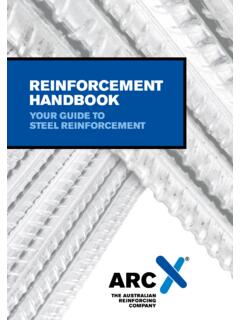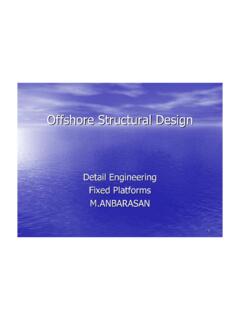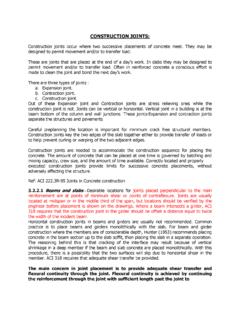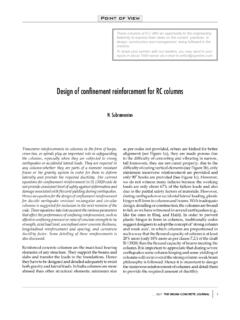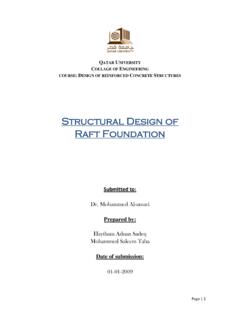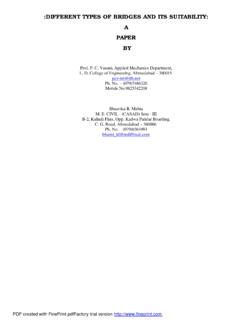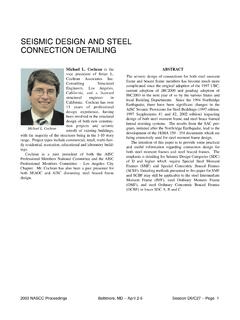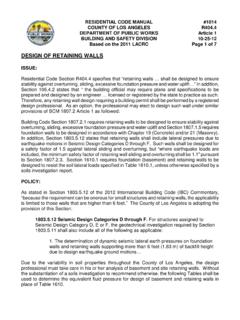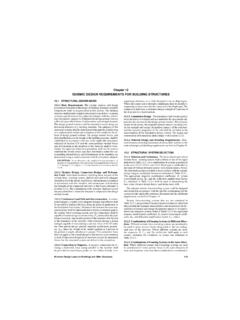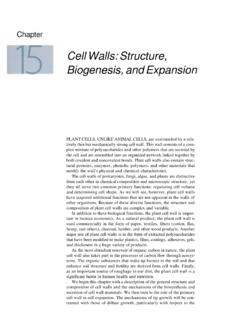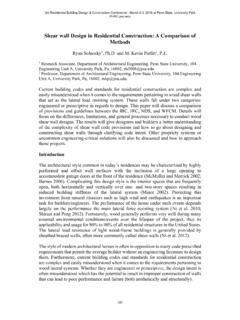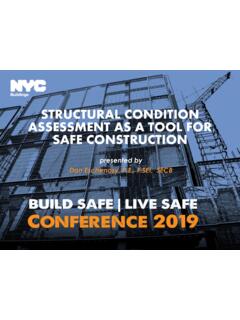Transcription of Types of Retaining Walls - Structural Engineers
1 Foundation EngineeringFoundation EngineeringLecture Lecture ##2323 Types of Retaining Walls -Gravity Walls - Pre-cast crib Walls - Gabion Walls - Reinforced concrete Walls - Sheet pile Walls - MS Walls (mechanically stabilized)- Slurry and Secant Walls - Soil nailingL. Prieto-Portar 2008 Retaining wallsare structure used to retain soil, rock or other materials in a vertical condition. Hence they provide a lateral support to vertical slopes of soil that would otherwise collapse into a more natural common materials used for Retaining Walls are:- Wood sheets;- Steel and plastic interlocking sheets;- Reinforced concrete sheets;- Precast concrete elements (crib Walls and block Walls );- Closely spaced in-situ soil-cement piles;-Wire-mesh boxes (gabbions);-Wire-mesh boxes (gabbions);- Anchors into the soil or rock mass (soil nailing).Earth- Retaining StructuresExternally Stabilized SystemsInternally Stabilized SystemsIn-Situ WallsGravity Walls -Sheet Pile- Steel- Concrete-Soldier Pile-Cast In-Situ-Slurry-Massive- Stone-Un-reinforced Masonry- Un-reinforced Concrete- Cantilever-Reinforced MasonryReinforced SoilsIn-Situ Reinforcement-Reinforced Earth-Geotextile-Soil Nailing-Reticulated Micro-piles-Slurry- Secant- Tangent- Soil CementCantileveredBraced-Cross-Lot-Raker sTied-Back-Augered-Straight-Belled-Press ure-Injected-Screw-Dead-man-Reinforced Masonry-Reinforced Cement-Counter-fort and Buttress-Gabion-Crib-Bin- Cellular CofferdamHybrid Systems- Tailed Gabions- Tailed MasonryMassive Gravity Walls are the earliest known Retaining structures.
2 They are built from solid concrete or rock rubble mortared together. The lateral forces from backfill is resisted by the weight of wall itself, and due to their massive nature, they develop little or no tension. Therefore, they are usually not reinforced with steel. Gravity Walls are economical for heights up to 3 m (10 feet).Mass concrete with battered concrete with battered concrete with stepped and Walls are made up of interlocking individual boxes made from timber or pre-cast concrete. The boxes are then filled with crushed stone or other coarse granular materials to create a free-draining structure. There are two basic Types of crib wall: - Timber, and- Reinforced pre-cast pre-cast concrete crib wall, part of an exit ramp for S-112 in Miami, built in timber crib poorly designed timber crib wall, slowly slowly collapsing timber crib wall has lost the strength of its soldier pre-cast panel crib wall.
3 Note the drainage apron at the toe of the are multi-celled, welded wire or rectangular wire mesh boxes, which are then rock-filled, and used for construction of erosion control structures and to stabilize steep slopes. Their applications include,- Retaining Walls ,- Bridge abutments,- Wing Walls ,- Culvert headwalls,- Outlet aprons,- Shore and beach protection Walls , and-Temporary check check gabbion wall is providing temporary slope stability until the vegetation covers the hill gabbion wall used for a parking lot at a Caribbean holiday example of a low head weir built with gabbions at Los Alamos Canyon, Arizona. (CE Oct. 2000).Cantilever Walls are built of reinforced concrete and are typically composed of a horizontal footing and a vertical stem wall. The weight of the soil mass above the heel helps keep wall stable. Cantilever Walls are economical for heights up to 10 m (32 feet).
4 Typical costs in 2005 is approximately $ 80 wall with wall with crane is lifting a wall form to cast this reinforced- Retaining 30-foot tall reinforced concrete wall was being built in Atlanta, Georgia, in 1980 as part of the renovation of a portion of delay in construction has lead to a partial erosion of the abandoned counter-fort Retaining wall that had been used as a bridge from Geo Tech Systems is shown here, being installed behind a bridge abutment to reduce the lateral earth pressures on the wall. Performance has been equivalent to soil and crushed rock basement wall was insufficiently reinforced to carry the active earth pressures imposed upon its that the collapsed concrete blocks do not show any type of CBS wall collapse due to insufficient CBS wall collapsed due to improper reinforced concrete wall is collapsing due to improper load on the wall from water can be relieved with weep holes and properly drained wall has a geotextile filter and a drainage stone wall has weep holes, but the clay coming through indicates lack of garden wall in the foreground is drained with weep holes, whereas the one in back is garden wall is rotating away from the vertical, and will eventually lacks both reinforcing and weep Stabilized Earth (MSE) Walls are among the most economical, and most commonly constructed.
5 Contrary to other Types , the MSE Walls are supported by the soil, and not the other way around. They are supported by selected fills (granular) and held together by reinforcements, which can be either metallic strips or plastic meshes. Typical prices range from $ 25/sf to $ 45 MSE ) Panel Walls ,A) Panel Walls ,B) Concrete Block Walls , and C) Temporary Earth first MSE wall built in Florida was for Metro-Rail s Medley Yard. The first step was to build this temporary soldier pile and lagging wall to retain the Hialeah Expressway (NW 74thStreet).This photo shows a close-up of the soldier pile and wood lagging steel W-sections (soldier piles) were vibrated into the soil at 6-foot intervals. The soil was retained using the wooden boards (lagging) clipped to the front of the W-sections. A cheaper alternative is to place the beard behind the steel, and let the soil press them into place.
6 The disadvantage of this method is that the wooden lagging leaves large voids in the ground. The extra expense large voids in the ground. The extra expense of closing these voids makes the traditional method less practical. The excavation shown will be the location of the descending ramp for the Metro-Rail trains entering the Yard (on the left). Note the highly contaminated soils and water at the wall is begun with a continuous footing. This photo is at the beginning of the first rows of pre-cast concrete panels have been placed upon the continuous panels are aligned and sealed to prevent the escape of groundwater through the metal strips are laid out behind the galvanized metal strips are bolted to embedded anchor tabs in the concrete the metal strips are bolted to the panels, the granular fill (high ) is spread in 6 to 12 the granular fill can be done by a front loader or the Hialeah X-way at left, and the Metro-Rail piers at right.
7 The MSE wall is in coal bin in Pennsylvania shows a novel use of an under-ground storage of the coal for a thermal power plant. The top frame enclosed the coal from rain and snow, and eliminates the eliminates the ugly view of coal piles around industrial typical MSE wall provides the advantage of cheaper Walls to attain a greater traffic capacity in smaller MSE Walls provide access to railroad and highways through this sloped alternative to the MSE Walls is the MS concrete block Walls shown photo shows an MS Temporary Earth Pile to build continuous Walls for waterfront structures and for temporary construction wall heights > 6 m if used with anchors. Can be made of steel, plastics, wood, pre-cast advantages of using steel sheet-piling:1. Provides higher resistance to driving stresses;2. Is of an overall lighter weight;3. Can be reused on several projects;3. Can be reused on several projects;4.
8 Provides a long service life above or below the water table;5. Easy to adapt the pile length by either welding or bolting; and6. Their joints are less apt to deform during bridge is being widened, and the traffic is maintained with this temporary temporary steel sheet piling wall is braced with horizontal W-beam walers and inclined ground anchors (their tied are seen on top of the walers).Soldier Piles and Lagging type of wall was known to Roman military Engineers , and was used for deep excavations. It is a relatively inexpensive system, easy and fast to construct. It is primarily limited to temporary construction, and cannot be used in high water table conditions without extensive dewatering and expense. It is not as stiff as other Types of Retaining slurry wall refers to the method of construction. Specifically, the digging of a deep trench with a special bucket and crane.
9 As the trench becomes deeper, the soil is prevented from collapsing into the trench by keeping the hole filled with a slurry . This slurry is a mixture of water with bentonite (a member of the Montmorrillonite family of clays). The bentonite makes the slurry thick, but liquid. This keeps the soil lateral Walls from collapsing into the excavation. When the excavation reaches the intended depth, the slurry filled excavation is reinforced with steel and carefully filled with concrete. These Walls have been built to 100 foot depths and range from 2 feet to 4 feet in thickness. These Walls have been built to 100 foot depths and range from 2 feet to 4 feet in thickness. The panels are typically 15 feet to 25 feet long, and are linked with one another through tongue and groove type seals (to prevent the intrusion of groundwater into the future underground Walls have the advantage of being stiffer than sheet pile Walls , and hold back the soil better than soldier piles, lagging and steel sheeting.)
10 They also tend to be more watertight than other excavation anchored Retaining wall for a residence built on top of a stabilized Pile Walls are formed by the intersection of individual reinforced concrete piles. These piles are built by using drilling mud (bentonite) and secant piles overlap by about 3 alternative are the tangent pile Walls , where the piles do not have any overlap. These piles are constructed flush with each important advantage of secant and tangent Walls is the increased alignment flexibility. The Walls also may have increased stiffness, and the construction process is less also may have increased stiffness, and the construction process is less the disadvantages are that waterproofing is difficult to obtain at the joints, their higher cost, and that vertical tolerances are hard to achieve for the deeper Walls are being built to construct this subway Walls do not rely on their mass to retain the soil.
